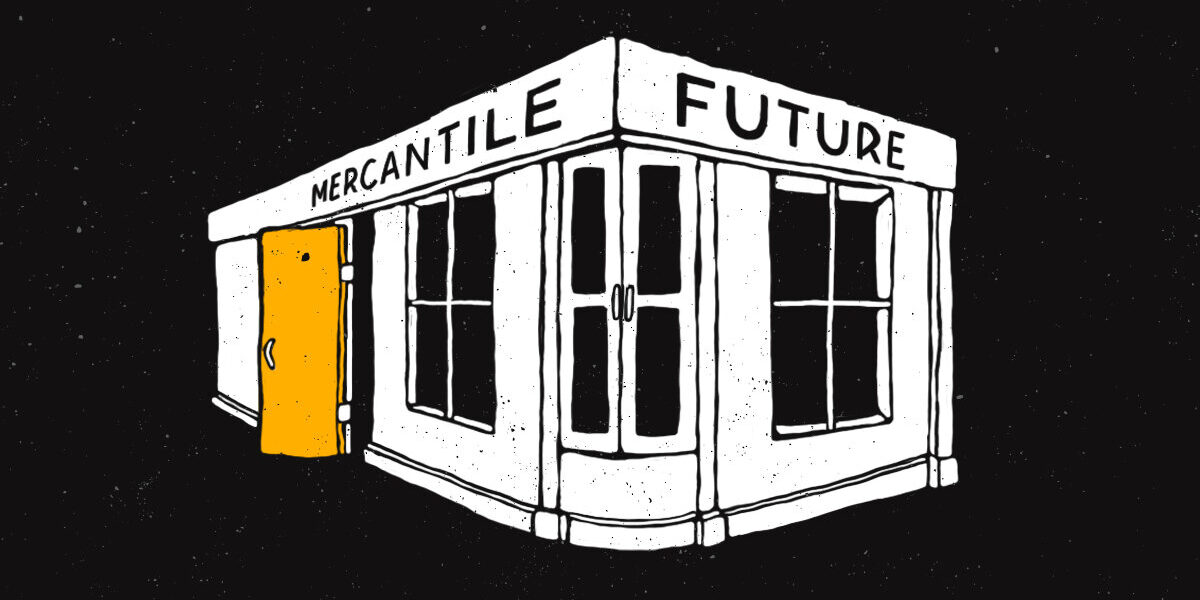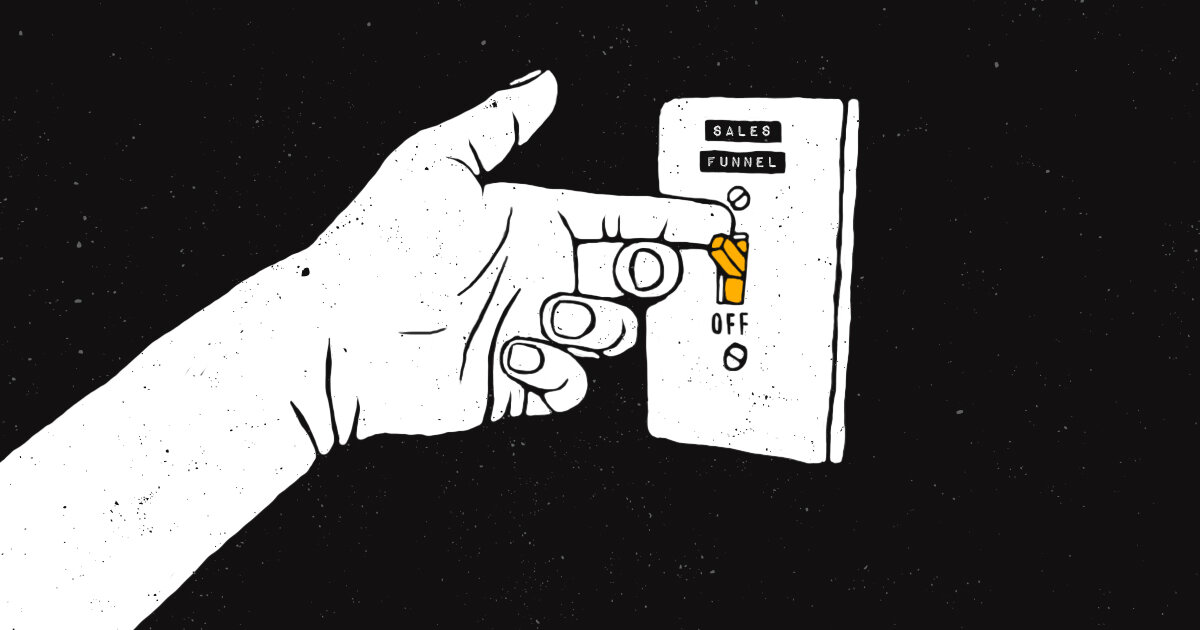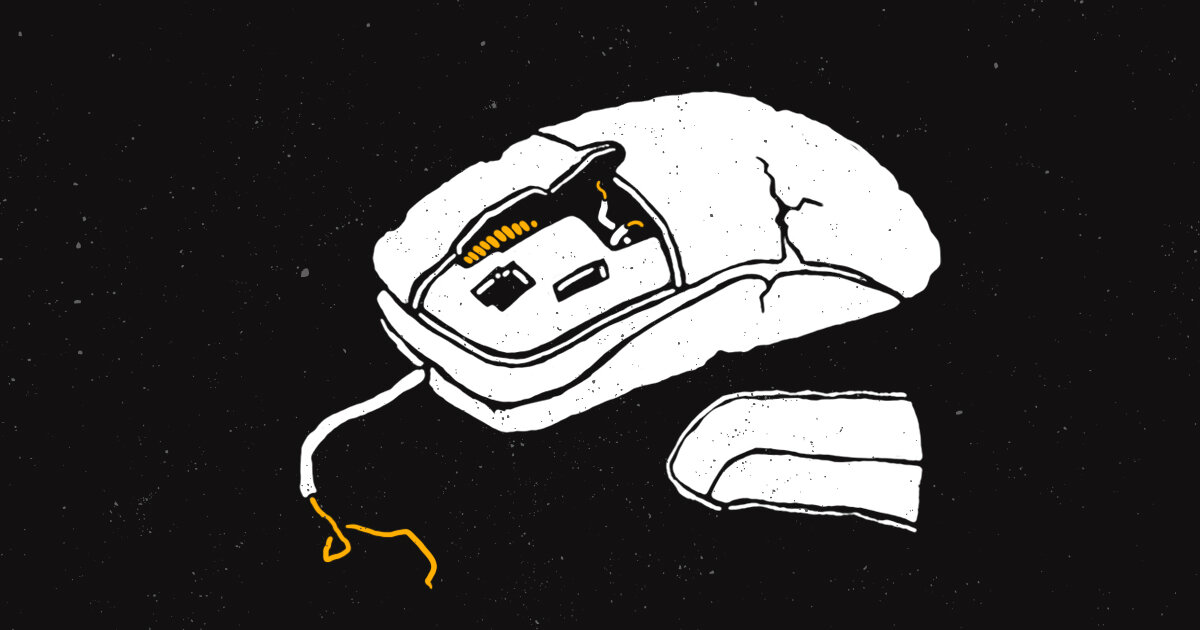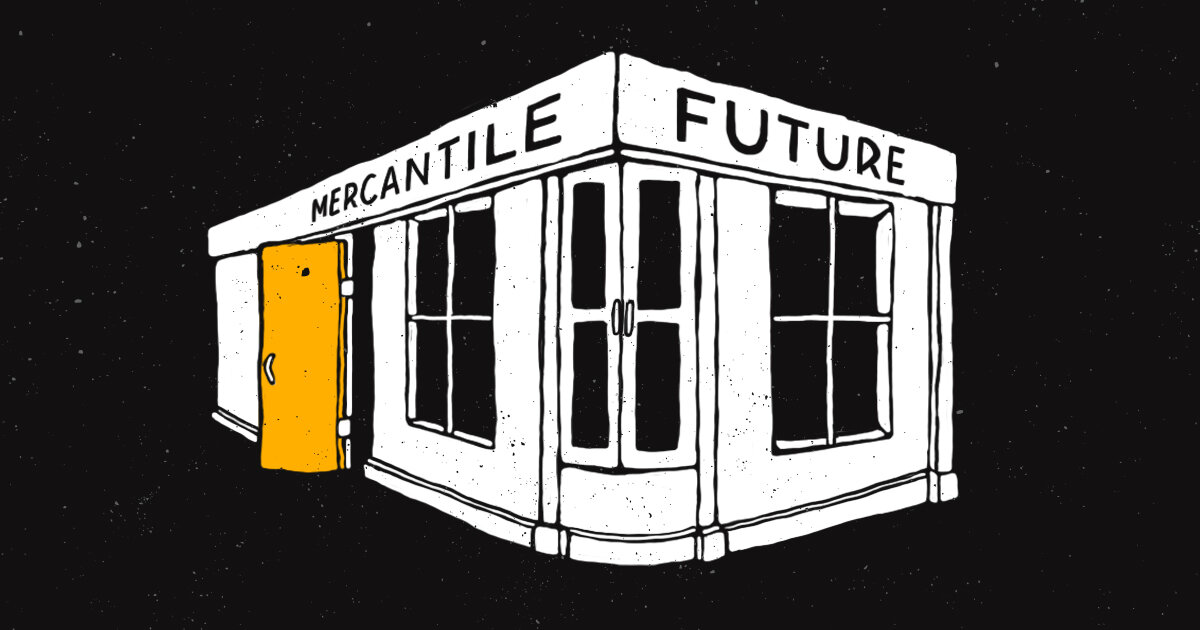When You Can’t Trust The Brand, Trust Each Other
The future of marketing has been coming for a while and has, finally, arrived. Unexpectedly, the future is very much like the past, only moreso. (As the saying goes.)
Its appearance means that brands – particularly in the B2B space – must now radically redefine how they think about developing a pipeline for their business. What’s essential? What’s superfluous?
This reinvention, two decades in the making, is amending the definition of success in marketing and sales. It’s challenging long-held truisms.
It’s reminding us of wisdom that existed before the digital world became all we could see.
And while a great deal of the future will still play out on screens and devices, the rules will come from a different time, forcing into context these past 20 years, when we foolishly believed data and bots could build trust with pixels and propaganda.
Upsetting that old legacy model of marketing, and unsettling our digital biases, is the only way forward. I’m going to address three biases embedded in that legacy model, followed by how we reorient ourselves to the future that is currently breaking in.
A future that I’m calling: mercantile marketing.
Bias #1: The Sales Funnel (and How It Went Dark)
In the past century, there were two functions of revenue generation: sales and advertising. Sales was an in-house function where cold prospects were warmed up through human connection and the power of persuasion. Advertising was an outside function, generally saved for retail products and service businesses to help add velocity to the sales functions. The journey from stranger to buyer was defined by a “sales funnel” where well-meaning humans were squeezed from the fresh air at the top of the funnel to the suffocating close at the bottom where “deals are done.
Marketing arises as a hybrid of these two worlds. What if we could put things throughout the funnel that would accelerate the sale? What if sales (an expensive department with big commissions and equally large egos) could be limited to bottom of the funnel (BOFU) activities, and we use the power of words and images to “prequalify” at the top of the funnel (TOFU)?
With the advent of the internet, these TOFU activities became cheap, fast, and easy. Suddenly marketing had the data-driven power to run the whole funnel. Maybe we’ll never have to talk to customers again? And for about a decade, decadence reigned. Buying attention on the internet was the lowest of bars, and credibility was a commodity that could be sacrificed for a little bit of quick attention. The syrupy drone of direct response copy overwhelmed the digital airwaves as every feed became clickbait, every headline a hook with no worm.
But as with all things, the pendulum was set to swing back. The extreme automation created by the digital/performance marketing craze triggered a backlash in buying public.
No one wants to feel like they’re being pushed through a funnel. It’s even worse when the thing doing the pushing is a bot.
The rising demand for digital privacy found its champion in Apple and its devil in Facebook, with Google addling in between with its infamous moral ambiguity.
Access points to the web (email, social, apps, devices) began closing their doors to the data trackers (known as third-party cookies), and suddenly, the exact analytics that could guarantee you cheap customers could no longer be trusted.
Simultaneously, consumer trust in brands and marketing plummeted. Falling precipitously for all consumers and collapsing entirely for the increasingly powerful Millennials and non-white consumer. (Gartner, 2019). Today, consumers are more interested in a TV commercial than a digital ad, and both suffer painful losses up against the old classic: referral from a friend.
Digital marketing was built for the funnel. But the funnel went dark and now doesn’t even really exist at all.
Bias #2: The Clicking Customers (and How They Went Incognito)
“All marketing is digital marketing.” I wrote that some years ago in a fit of trying to feed the voracious content engines of the internet. I couldn’t have been more wrong. I was just awakening to how punchdrunk we all were to the internet’s ubiquitous role in our lives. Before the pandemic broke us. Before we remembered there was a sky and rooms with faces.
The rise of the internet’s prowess in marketing convinced all of us (nearly) that the only actions worth taking have attributable results—the ever-elusive “ROI.” Clicks on ads which led to clicks on landing pages which led to clicks on Book-A-Call buttons which led to clicks on purchases which led to clicks on surveys. Clickity clackity.
The drumming of these clicks and their attending metrics seduced marketers and executives into believing that the only logical marketing to do was the clickable kind. Because if you couldn’t attribute revenue to the activity? If you couldn’t use it to follow the prospect around the internet, what was the use?
Suddenly every website is full of gates. Required email addresses for e-books, lead magnets, and always-on webinars. I’ve even heard of sites now where you put in your email address to watch the videos. All to “build the list” and “track opportunity.”
But today, consumers like you and me are savvier than such tactics dare admit. Every sign-in block and CTA (call-to-action) is now met with skepticism about what barrage of engagement emails are sure to follow.
Instead of asking, “Am I interested in this content” when offered clickable resources, consumers ask the question, “Am I ready to buy?” because they know that click will send them into a flurry of sales material and outreach that doesn’t serve them, only you.
C-suite decision-makers are keeping their buying intent close to the chest, discovering vendors and partners through word of mouth, internet stalking, and incognito activities that will never hit the CRM. They are intentionally hiding digitally so that they can engage only when they are well along in their procurement decision, protecting their inboxes and their time.
In this reversion to the past, the companies who have broad and accessible storefronts, content operations, and leaders who are out in the world, freely and publicly get the first right of refusal. Their public brand is accessible and personal as the old town general store, leaving everyone to wonder why anyone still shops at the superstore out by the highway.
Boutique is no longer a word describing size but attitude. Brands that love the smallest community of customers possible, catering passionately to them with no guarantee or measure of return, to them go the spoils. Their love of the customer is its own reward.
Bias #3: All Attention is Good Attention (And How the Mighty Have Fallen)
In that classic leadgen org I described in bias #1, I’ve left out one of the key players: the publicist. More than PR, generating publicity (of any kind, really) has been at the heart of marketing since its rise into the C-suite. Attention could always be spun into story, and eyeballs were worth whatever it took to acquire them.
The same philosophy survived the padded shoulders of the 80s and 90s and lived on in the digital age through traffic management. Ranking on Google, increasing web visits, and the ever-elusive “views” on social became the commodity for value. The gatekeepers of platforms like LinkedIn have little to offer except “post every day!” “About what?” we ask. “It doesn’t matter; the algorithm will save us all!” A brief age of instantaneous fame known as virality was accessible to even the most novice of internet actors, creating a cottage industry of attention peddlers and consultants helping anyone and everyone get the “traffic” they so desperately deserved.
But as with all things, the rubber band snaps back eventually. In this case, a world where anything goes as long as it generates traffic and views gave way to a backlash affectionately known as “cancel culture.” I will not litigate here the virtues or villainy of cancel culture, only acknowledge the extent to which it has changed the playing field.
The internet is actively splintering, dividing once homogenous buying groups into micro-communities with shared values and priorities. These groups, dependent upon each other as gatekeepers (because institutions are inherently untrustworthy), are radical consumers of reputation. No business is ever what it says it is. A business is what others consistently say about it. And transparent ploys for attention, without the requisite self-awareness, will spread a poison of discontent through these communities faster than mold on old bread.
Facebook’s callous disregard for privacy has red-lettered the brand. While its revenues rise in the short term, its expansive user base scrambles for ways to connect elsewhere. The platform is selling the vapor of past attention to ad buyers who don’t realize the audience they are chasing is no longer on the platform.
If you sow seeds demonstrating you will do anything for the sale, the micro-community of potential customers will take notice and train each other to ignore you.
By contrast, when brands center and prioritize the customer experience, only market that which is deeply true, and only seek recognition for where they legitimately lead, opportunities abound. The integrity of truth running from skin-to-bone in an organization is irrefutable in today’s world of community-driven commerce.
The truism holds with caveats: If you build it, they will come. But today, the “it” is a community of trust.
The Mercantile Future
Not long ago, it became clear to me that the 21st century’s primary aim was to dismantle the achievements of its preceding century. Industry would give way to environment. Homogenity to diversity. The centering of the individual to the rise of community.
What was not clear to me then, what exactly would rise in its place. Until I came across the quote from Faith Popcorn (yep, her real name) referenced at the beginning of this article:
The future is like the past, only moreso. – Faith Popcorn, Futurist and Marketing CEO
Of course, this raises the question, which past? We’ve already torn out the foundations of the last 20 years of marketing progress and shaken the core of the 20 years before that. If everything comes back into fashion eventually, what comes back next?
And then I remembered Ahoy Fountain.
When I was very young, on the corner of Washington and Edgington was Carol Ann’s. A locally owned women’s fashion boutique where my mom would shop, and I would get lost in the rounders. Carol Ann went to my church, and her father was our state representative. When Carol Ann got out of the clothing business, the building was leased by a pharmacist, which it stayed for as long as I can remember. Melody Hoy, the town pharmacist, and her husband had vintage dreams. Cut a hole in the brick wall between the pharmacy and its adjacent building and opened Ahoy Fountain.
It was exactly as you would want it. Black and white tile. Coca-Cola signs on the wall, the world’s best Root Beer Floats, and where I was introduced to the perfect fountain drink: The Green River.
On hot summer days, we’d pull up to the parking spaces across from the county courthouse, unload the car, and belly up to the bar. In the summer, the counter was worked by the high school guidance counselor, who would relish the opportunity to get the pulse of the latest gossip. Tony (everyone called him by his first name) was the arbiter of cool to me. The only adult allowed in the teenage zeitgeist. A gatekeeper.
For my little world, the borders defined by the black and white tile of Ahoy Fountain determined a piece of reality. When I didn’t know where to go, I went there, hoping to find someone (usually Tony) to reorient me to the world as I knew it.
As good as the root beer floats were, you didn’t go to the Ahoy Fountain for the treats or the hamburgers. You didn’t even go for the nostalgia. You went because your community deemed it worthy, and its ambassadors, the soda jerks led by the high school counselor, knew your name and your place in the world.
When necessary, you could pop through to the pharmacy and pick up your prescription without mentioning your name. Melody knew everyone by heart.
We thought the digital world would connect us all. It didn’t. It fractured us into micro-communities.
No longer defined by the intersection of streets, but by the intersection of interests. And in these micro-communities, there are gatekeepers, treats, open walls between businesses, and in the best of scenarios, people who know your name. Like the Ahoy Fountain, the future is mercantile, reinvigorating and reinventing the values of a different time—timeless values because they are what makes us human.
It contains all the elements of the classic main street of storefronts, long forgotten. And those who master it, both in-person and online, will find themselves in leading positions in their chosen industries.
The Mercantile Future is:
-
Marketed in Community: Relationships are the crucible in which brand and demand are formed. Because brands now exist in digital cul-de-sacs where a select group of buyers, brokers, agents, and competitors work and play, the rules of community apply in ways they haven’t since the corner general store: follow-through, consistency, word-of-mouth, value exchange, and connection without the threat of coercion.
-
Powered by reputation. Reputation, the legitimate and true-to-experience credit you get for doing what you say you do (or the opposite), is the core of marketing. Because reputation can only be built reliably in community (see #1) then it is built primarily by customer experience. The most important part of your marketing is the happiness of your current customer. In the mercantile future, there is only a shade-of-gray difference between customer success and generating demand.
-
Where Buyers are Received Not Acquired. The small-town lawyer across from the courthouse isn’t acquiring business by sending out engagement series emails and hooking people with long-winded persuasive arguments. Mercantile brands, brought to life in community by reputation, live by customers that look for them, not the other way around. At scale, this happens through robust content and demandgen operations that give pre-buyers full control over their experience, resists any linear journey, and trusts that unsolicited value produces future demand.
-
Branded. Not with flashy logos and taglines and sayings. But with public trust that distinguishes the company from its competitors. Transactional marketing does a terrible job of creating demand, distributing reputation, and building community. But brand awareness, powered by the three above factors, becomes the beginning of a long-term growth curve. I always say that brand is actionable reputation.
The Past is Rehearsal
The core principles of a mercantile future apply up and down the capitalization scale and across industries. They are the result of a reversion, moving back to the human elements of trust after the digital stand-ins have failed to satisfy. We are bellying up to the fountain bar, drinking our Green Rivers.
Businesses that wish to rise above the trends, the gurus, and the gimmicks must get back to the foundations, building the infrastructure for community, reputation, demand, and brand. These interlocking factors, all interdependent on each other, are references to an analog past—a world of barbershop poles, florists, and handshake deals.
I can feel the leather barstool beneath me and smell the vanilla as if I was there all over again. When my life was lived at the intersection of Edgington and Washington, I thought we were relishing the past. In fact, we were rehearsing the future.
Welcome to the Mercantile Future.




